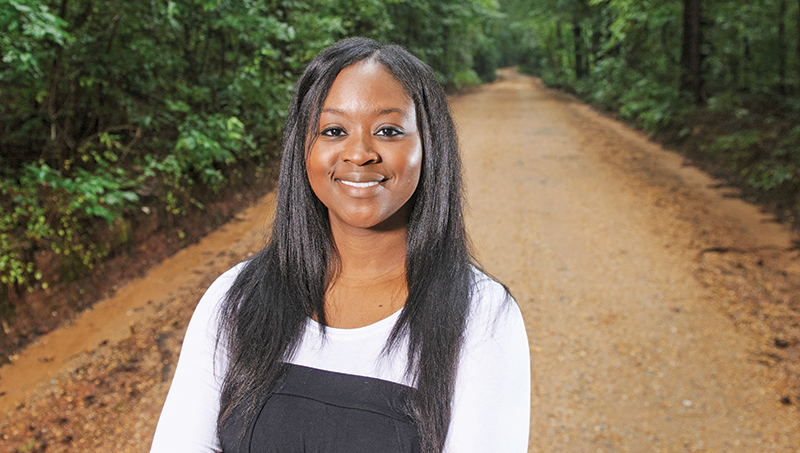Students, faculty and the public were brought together to reflect on their definition of diversity and how they approach it Wednesday night in Russell Hall.
Robin Boylorn, assistant professor of interpersonal and intercultural communication, encouraged the audience to embrace different social identities during her presentation of the Last Lecture, a graduate school program that invites one professor to speak to a group of UA students for as if for the last time.
“We need to be willing to understand diversity, and in order to understand it, we have to talk about it so that we can learn past stereotypes,” Boylorn said. “We have to be willing to have difficult dialogues and fluctuating emotions and knots in the pits of our stomach. We have to talk about it and keep the issues on our tongue.”
The talk, titled “Overcoming (In)Difference: Reflections on Empathy, Apathy and Diversity,” focused not only on Boylorn’s definition of diversity, but her perception of the problems and solutions.
She said one of the problems in overcoming barriers of difference is apathy regarding social justice issues, which lulls people to complacency and convinces them to believe things are not relevant unless directly affecting them.
“When we are apathetic, we are desensitized to discrimination, even when we are the ones being discriminated against,” she said. “This is a dangerous perspective and oftentimes causes folks to be bystanders or witnesses to injustice and oppression.”
Referencing a tendency in society to disregard the differences between people, Boylorn said this “colorblindness” is actually a contributing problem rather than a solution.
“A common misconception is that seeing color or noticing or mentioning difference is a form of discrimination, but it is not,” she said. “Seeing color and noticing other aspects of difference is an inevitability, and it’s important to note that seeing color is not discriminatory. Treating someone badly because of their color is discriminatory.”
Boylorn said much oppression and injustice goes untreated because it is kept invisible.
“We are conditioned and socialized to avoid or ignore difference, so we pretend that we don’t see or notice difference in an effort to be polite or politically correct or progressive. But these efforts are all wrong,” she said.
Sherry Kirksey, professor of human development and family sciences, said although some of her perspectives differ from Boylorn’s, she liked the idea of recognizing difference but discounting its oppression.
“When she was talking about colorblindness, whether it’s homophobia or whatever it is, it’s not that you don’t see it or you don’t recognize it. It’s the mistreatment,” Kirksey said. “That was probably the best thing that was said.”
Boylorn said she prefers people to acknowledge her race rather than pretend it doesn’t exist because it is part of her identity.
“When someone says, ‘I don’t see your color,’ it is the equivalent of saying, ‘I don’t see you,’” she said.
To combat apathy, Boylorn said she encourages a culture of empathy by imagining having a similar experience and existence as someone different, and asking “How would you feel, and more importantly, how would you want to be treated?”
“You don’t lose who you are by empathizing with others. It simply means that you make space for people to be themselves and you honor their differences instead of stigmatizing them,” Boylorn said. “Empathizing means that you feel for them and you feel with them, so in order to empathize, you have to be aware and willing to acknowledge that ‘isms’ exist.”
She said she believes exposure is an important combatant to the problems regarding diversity and that one way this can be enforced is by putting oneself in situations they normally wouldn’t.
“I oftentimes share in my class that if you encounter difference for the first time and you are not made uncomfortable, then you’re probably not doing it right,” Boylorn said.
Gaby Wilson, a junior majoring in telecommunication and film, said she thinks the most important part of Boylorn’s lecture is students’ exposure to the idea of diversity.
“I think that on a campus such as The University of Alabama, with all its history and all the things that are still happening, that it’s very vital to the growth of this university, especially since there is a big diversity push for people to actually understand what it is and what it looks like,” Wilson said. “It’s not just numbers, it’s about understanding, and,like Dr. Boylorn said, it’s about empathy.”
Boylorn said she hopes students will embrace the diversity of social identity and fight the urge to be comfortable.
“We go through most of our lives sitting at the same metaphorical table with the same familiar faces, saving seats and deterring difference,” she said. “But what might happen if we play musical chairs in the lunchroom, and in the classroom, and in the board room, and in the living room? What might happen if we invited difference over for dinner?”









